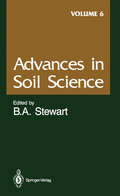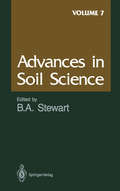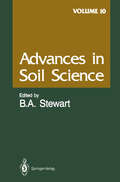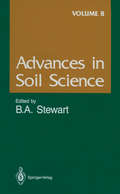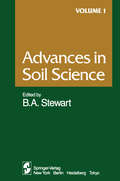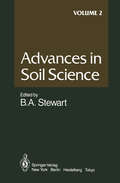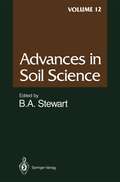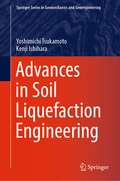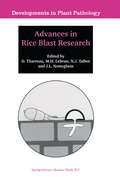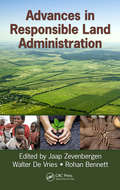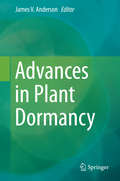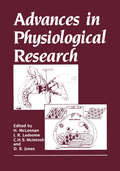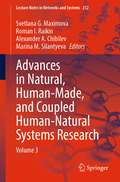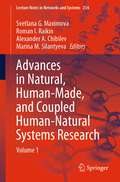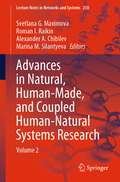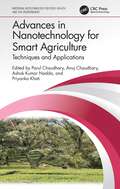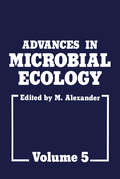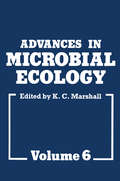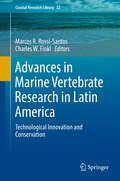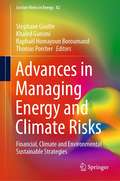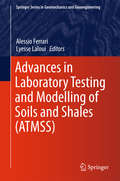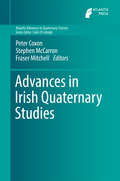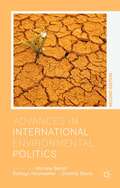- Table View
- List View
Advances in Soil Science (Advances in Soil Science #6)
by R. R. Allmaras S. C. Gupta J. Kubota A. D. Scott S. J. Smith D. L. Sparks M. E. Sumner D. Van Campen J. L. Walworth R. M. WelchThe world needs for food and fiber continue to increase. Population growth in the developing countries peaked at 2. 4 percent a year in 1965 and has fallen to about 2. I percent. However, in many developing countries almost half the people are under 15 years of age, poised to enter their productive and reproductive years. The challenges to produce enough food for this growing population will remain great. Even more challenging is growing the food in the areas of greatest need. Presently the world has great surpluses of food and fiber in some areas while there are devastating deficiencies in other areas. Economic conditions and the lack of suitable infrastructure for distribution all too often limit the alleviation of hunger even when there are adequate supplies, sometimes even within the country itself. World hunger can only be solved in the long run by increasing crop production in the areas where the population is growing most rapidly. This will require increased efforts of both the developed and developing countries. Much of the technology that is so successful for crop production in the developed countries cannot be utilized directly in the developing countries. Many of the principles, however, can and must be adapted to the conditions, both physical and economic, of the developing countries. This series, Advances in Soil Science.
Advances in Soil Science (Advances in Soil Science #7)
by D. W. Anderson E. Bresler W. W. Frye L. Metzger M. S. Smith J. J. Varco J. Venkateswarlu B. YaronThe world population in 1950 was 2. 5 billion and is more than 5 billion today. The agriculture community, however, has responded remarkably well to meeting the increased need for food and fiber. While the population growth during this period averaged almost 2% annually, the production of grain increased at an even faster rate. From 1950 to 1973, grain production increased 3. 1% annually, but slowed to about 2% from 1973 to 1984. There fore, as a whole, the world has more grain per capita available today than ever before. Several countries that were food importers just a few years ago are food exporters today. The world carry-over stocks today are the highest in years. While the major concern just a few years ago was whether the world could produce adequate food, the problem for many countries today is how to export their surpluses. Although the world as a whole has surplus food supplies, there are millions of people without adequate food to exist, and there are additional millions who have a bare subsistence diet at best. The average daily calorie supply for the developed countries is more than 3,300 per person, while the average for the developing countries is only about 2,200. The major global food produc tion problems have shifted from Asia to Africa, where malnutrition, poverty, and starvation are attracting world attention.
Advances in Soil Science: Volume 10 (Advances in Soil Science #10)
by E. G. Beauchamp D. Binkley R. J. Buresh S.K. De Datta S. C. Hart M. B. McBride J. W. Paul J. T. Trevors A. Van WambekeSoil is formed from physical and chemical weathering of rocks - processes described historically because they involve eons of time-by glaciation and by wind and water transport of soil materials, later deposited in deltas and loessial planes. Soil undergoes further transformations over time and provides a habitat for biological life and a base for the development of civilizations. Soil is dynamic -always changing as a result of the forces of nature and particularly by human influences. The soil has been studied as long as history has been documented. Numerous references to soil are found in historical writings such as Aristotle (384-322 B. c. ), Theophrastus (372-286 B. c. ), Cato the Elder (234-149 B. C. ) and Varro (116-27 B. c. ). Some of the earliest historical references have to do with erosional forces of wind and water. The study of soils today has taken on increased importance because a rapidly expanding population is placing demands on the soil never before experienced. This has led to an increase in land degradation and desertification. Desertifica tion is largely synonymous with land degradation but in an arid land context. Deterioration of soil resources is largely human induced. Poverty, ignorance, and greed are the indirect causes of desertification. The direct cause is mismanage ment of the land by practices such as overgrazing, tree removal, improper tillage, poorly designed and managed water distribution systems, and overexploitation.
Advances in Soil Science (Advances in Soil Science #8)
by A. R. Bertrand J. C. Day R. J. Gibbs P. M. Huang R. E. Meyer A.S.P. Murthy R. I. Papendick J. B. Reid J. L. SteinerAdvances in Soil Science is a review series relevant to all areas of soil science. These reviews, intended primarily for scientists, teachers, and students of soil science, also provide technical background information for many additional workers and groups interested in our natural resources and man's influence on them. This is the eighth volume in the series with an international list of contributors from the United States, India, Canada and New Zealand. It contains four review chapters on the following subjects: factors affecting aluminum transformations in soil; soil productivity in dryland regions of developing countries; changes in soil structure under different cropping systems; properties and management of the depleted soils of India. These contributions present valuable information on a diversity of topics and serve as an excellent source of references.
Advances in Soil Science (Advances in Soil Science #1)
by F. T. Bingham J. T. Cope H. V. Eck S.A. El-Swaify C. E. Evans L. B. Fenn L. R. Hossner R. Keren J. Letey P. Pathak T. J. Rego U. Schwertmann I. Shainberg S. Singh P. W. UngerThe world population in 1930 was 2 billion. It reached 3 billion in 1960, stands at 4. 6 billion today, and is expected to reach 6 billion by the end of the century. The food and fiber needs of such a rapidly increasing population are enormous. One of the most basic resources, perhaps the most basic of all, for meeting these needs is the soil. There is an urgent need to improve and protect this resource on which the future of mankind directly depends. We must not only learn how to use the soil to furnish our immediate needs, but also ensure that the ability of the soil to sustain food production in the future is unimpaired. This is indeed a mammoth task; a 1977 United Nations survey reported that almost one-fifth of the world's cropland is now being steadily degraded. This volume is the first of a new series entitled Advances in Soil Science. The diversity of soil makes it necessary for research to be conducted in many locations. There are basic principles, however, that are universal. This new series will present clear and concise reviews in all areas of soil science for everyone interested in this basic resource and man's influence on it. The purpose of the series is to provide a forum for leading scientists to analyze and summarize the available scientific information on a subject, assessing its importance and identifYing additional research needs.
Advances in Soil Science: Volume 2 (Advances in Soil Science #2)
by E. Bragg J. M. Lynch K. Mengel C. W. Rose K. WadaThe world population in 1930 was 2 billion. It reached 3 billion in 1960, stands at 4. 6 billion today, and is expected to reach 6 billion by the end of the century. The food and fiber needs of such a rapidly increasing population are enormous. One of the most basic resources, perhaps the most basic of all, for meeting these needs is the soil. There is an urgent need to improve and protect this resource on which the future of mankind directly depends. We must not only learn how to use the soil to furnish our immediate needs, but also ensure that the ability of the soil to sustain food production in the future is unimpaired. This is indeed a mammoth task; a 1977 United Nations survey reported that almost one-fifth of the world's is now being steadily degraded. The diversity of soil makes it cropland necessary for research to be conducted in many locations. There are basic principles, however, that are universal. This, Advances in Soil Sciences, presents clear and concise reviews in all areas of soil science for everyone interested in this basic resource and man's influence on it. The purpose of the series is to provide a forum for leading scientists to analyze and summarize the available scientific information on a subject, assessing its importance and identifying additional research needs. But most importantly, the contributors will develop principles that have practical applications to both developing and developed agricultures.
Advances in Soil Science: Volume 12 (Advances in Soil Science #12)
by S. K. Jalota B. D. Kay S. Komarneni P. B. Malla E. Murad S. S. Prihar M. E. SumnerSoil is formed from the physical and chemical weathering of rocks-processes described historically becau'se they involve eons of time-by glaciation and by wind and water transport of soil materials, which are later deposited in deltas and loessial planes. Soil undergoes further transformations over time and provides a habitat for biological life and a base for the development of civilizations. Soil is dynamic-always changing as a result of the forces of nature and particularly by the influences of man. Soil has been studied as long as history has been documented. Numerous references to soil are found in historical writings such as Aristotle (384-322 Be), Theophrastus (372-286 Be), Cato the E1der (234-149 Be), and Varro (116-27 Be). Some of the earliest historical references have to do with the erosional forces of wind and water. The study of soils today has taken on increased importance because a rapidly expanding population is placing demands never before experienced on the soil. This has led to an increase in land degradation. Land degradation is one of the most severe problems facing mankind. Volume 11 of Advances in Soil Science was devoted entirely to this critical area of soil science. This series, Advances in Soil Science, was established to provide a forum for leading scientists to analyze and summarize the available scientific information on a subject, assessing its importance and identifying additional research needs.
Advances in Soil Liquefaction Engineering (Springer Series in Geomechanics and Geoengineering)
by Yoshimichi Tsukamoto Kenji IshiharaThis book describes recent developments in soil liquefaction engineering and introduces more appropriate procedures than the current ones to evaluate triggering and consequences of soil liquefaction during earthquakes. The topics therefore cover all aspects of soil behaviour following liquefaction during earthquakes. The contents start with new approaches and new findings on characterisation of liquefaction resistance and undrained shear strength of fully saturated, partially saturated, and unsaturated sand, which are fully based on laboratory tests. New approaches and findings are then described on the use of in situ sounding tests for characterising triggering and consequences of soil liquefaction, including post-liquefaction settlement, lateral spreading, and stability against flow slide. All the topics are accompanied by illustrative case history data from recent major earthquakes in Japan.
Advances in Rice Blast Research: Proceedings of the 2nd International Rice Blast Conference 4–8 August 1998, Montpellier, France (Developments in Plant Pathology #15)
by N. J. Talbot J. L. Notteghem D. Tharreau M. H. LebrunAdvances in Rice Blast Research provides a complete overview of the research undertaken on the rice-blast pathosystem. This book gathers in one volume the most recent works on rice blast fungus genetics and molecular biology of pathogenicity, rice blast fungus population studies, and genetics and molecular biology of rice resistance to blast, including resistance gene cloning. It also presents the latest results on resistance breeding and resistance management strategies, epidemiology and disease management. This book is a must for plant pathologists and breeders working on rice blast and also to plant pathologists and breeders dealing with fungal diseases in general, because the rice-blast pathosystem is a model in plant pathology. Advances in Rice Blast Research provides a complete overview of the research undertaken on the rice-blast pathosystem. This book gathers in one volume the most recent works on rice blast fungus genetics and molecular biology of pathogenicity, rice blast fungus population studies, and genetics and molecular biology of rice resistance to blast, including resistance gene cloning. It also presents the latest results on resistance breeding and resistance management strategies, epidemiology and disease management. This book is a must for plant pathologists and breeders working on rice blast and also to plant pathologists and breeders dealing with fungal diseases in general, because the rice-blast pathosystem is a model in plant pathology.
Advances in Responsible Land Administration
by Jaap Zevenbergen Walter De Vries Rohan Mark BennettAdvances in Responsible Land Administration challenges conventional forms of land administration by introducing alternative approaches and provides the basis for a new land administration theory. A compilation of observations about responsible land administration in East Africa, it focuses on a new empirical foundation rather than preexisting ideal
Advances in Plant Dormancy
by James V. AndersonPlant dormancy involves synchronization of environmental cues with developmental processes to ensure plant survival; however, negative impacts of plant dormancy include pre-harvest sprouting, non-uniform germination of crop and weed seeds, and fruit loss due to inappropriate bud break. Thus, our continued quest to disseminate information is important in moving our understanding of plant dormancy forward and to develop new ideas for improving food, feed, and fiber production and efficient weed control, particularly under global climate change. Proceeding from the 5th International Plant Dormancy Symposium will provide an overview related on our current understanding of how environmental factors impact cellular, molecular, and physiological processes involved in bud and seed dormancy, and perspectives and/or reviews on achievements, which should stimulate new ideas and lines of investigation that increase our understanding of plant dormancy and highlight directions for future research.
Advances in Plant and Animal Boron Nutrition: Proceedings of the 3rd International Symposium on all Aspects of Plant and Animal Boron Nutrition
by Fangsen Xu Heiner E. Goldbach Richard W. Bell Patrick H. Brown Toru Fujiwara Sabine Goldberg Curtiss D. Hunt Lei ShiThis book reviews all aspects of boron research in recent years and is based on the Third International Symposium on all Aspects of Plant and Animal Boron Nutrition. This includes B sorption mechanisms in soils, deficiency and toxicity of B, B fertilizer application and basic research on the physiology and molecular biology of plant B nutrition, and nutritional function of B in animals and humans.
Advances in Physiological Research
by H. McLennan J.R. Ledsome C.H.S. McIntosh D.R. JonesThe XXX Congress of the International Union of Physiological Sciences took place in Vancouver, Canada, in July 1986; and this Volume contains a selection of the Review Lectures which formed part of the Congress programme. They cover most of the areas of contemporary physiology and were presented by distinguished scientists from many parts of the world. An innovation at this Congress was the inclusion in the programme of a number of lectures devoted to historical subjects. These lectures attracted large audiences at the meetings, and three of them also appear in this book. Finally, the Plenary Lectures which formed part of the opening and closing ceremonies and which deal with some aspects of Canadian physiological history, find a place here as well. The Editors are grateful to all of the authors who provided the manuscripts which go to make up this book, and to John Donald for his invaluable assistance in the preparation of the final text; as well of course to all of the contributors whose participation made the Congress the success which it was. It is hoped that this Volume will provide a useful memento of the event.
Advances in Natural, Human-Made, and Coupled Human-Natural Systems Research: Volume 3 (Lecture Notes in Networks and Systems #252)
by Svetlana G. Maximova Roman I. Raikin Alexander A. Chibilev Marina M. SilantyevaThis book enables readers to develop a multidisciplinary understanding of natural, human-made, and coupled human-natural systems. The authors explore the structure, function, and dynamic mechanisms of various systems, both natural and human-made, as well as analyze their reciprocal interactions under the concept of “coupled human-natural systems.” The chapters challenge traditional planning and management assumptions and strategies for natural resources, human-altered systems, and the environment.Acknowledging the critical role of effective regulations, policies, and governance structures, the authors analyze advanced research and practices on policy design for managing natural, human-made, and coupled human-natural systems. They conduct impact evaluation and integrative ecosystems assessment, as well as discuss policy interventions and decision-making strategies. They acknowledge the localization of policy design, considering regional and global dynamics that shape responses of local human-made and coupled human-natural systems. A special collection of chapters analyzes legal foundations for sustainable development and strong institution. The authors explore models from both natural and social sciences to obtain and present significant research results.The book is a dispensable source of sustainability research and practice in human-made, natural, and coupled human-natural systems. It is for the scholars, practitioners, and advanced graduate students interested in systems theories, methodologies, and applications.
Advances in Natural, Human-Made, and Coupled Human-Natural Systems Research: Volume 1 (Lecture Notes in Networks and Systems #234)
by Svetlana G. Maximova Roman I. Raikin Alexander A. Chibilev Marina M. SilantyevaThis book is a collection of cutting-edge and cross-disciplinary studies on natural, human-made, and coupled human-natural systems, addressing the challenge of developing integrated knowledge from multiple disciplines. The authors explore the structure, function, and dynamic mechanisms of various systems, both natural and human-made, as well as analyze their reciprocal interactions under the concept of “coupled human-natural systems.” These interactions are used to understand feedback, nonlinearities, thresholds, time lags, legacy effects, and path dependencies, emerging across multiple spatial, temporal, and organizational scales. In other words, this book is a collection of advanced research on unique properties of natural and human-made systems, as well as human-environment dynamics, reciprocal relationships, and cross-scale interactions.The authors outline prospects on building a holistic view of social development and coherent sustainability. Among the topics covered are the following: human networks research; adaptation of local people to social and environmental challenges; coupled dynamics of socioeconomic and environmental systems; critical issues in social science climate change research; education for greater sustainability; peace, justice, and strong institutions; advances in cultural traditions and strategies for social stability; innovative development and barriers to sustainable development; economic systems in the age of digital changes and unstable external environments. The scholars analyze how more effective technologies can enhance resilience, reduce vulnerability, and minimize human impacts on natural systems, taking into consideration critical thresholds to prevent harmful feedback to human systems.The authors grasp the complexity of systems by integrating knowledge of constituent subsystems and their interactions. The framework developed by the authors is used to integrate human and natural systems for achieving greater sustainability, covering critical threats, challenges, and best governance approaches and practices. The research results obtained from studies on coupled human-natural systems are stronger, the authors argue, if compared with traditional (discipline) approaches.
Advances in Natural, Human-Made, and Coupled Human-Natural Systems Research: Volume 2 (Lecture Notes in Networks and Systems #250)
by Svetlana G. Maximova Roman I. Raikin Alexander A. Chibilev Marina M. SilantyevaThis book is a unique collection of advanced research on natural, human-made, and coupled human–natural systems. The contributors analyze the current state of knowledge, address methodological challenges, and explore engaging cases. The chapters demonstrate the balanced disciplinary strength and discuss interdisciplinary perspectives. The authors undertake a holistic and spatially integrative analysis to understand the sustainability of environmental, economic, and social systems, emphasizing the coupled nature of such systems. In particular, the chapters explore biodiversity conservation and natural resources, the sustainability of natural and human-altered ecosystems, sustainability–vulnerability issues in coupled human–natural systems, mechanisms to foster sustainable environmental practices, eventually accumulating sustainability research and practice in various fields. More than that, the challenges of educational and economic systems are studied closely. The authors rely on unique data, develop regional and local knowledge, and explore global trends at local scales. A separate focus is devoted to human health and well-being. The book has seven sections: (1) Advances in Natural and Coupled Human–Natural Systems Research; (2) Economic Systems in the Age of Digital Changes and Unstable Environments; (3) Sustainable Social Systems, Migration Flows, and Social Cohesion; (4) Taking Action for Greater Security and Effective Partnerships for Sustainable Development; (5) Systemic Challenges and Changes in Education Systems in Russia and Around the Globe; (6) Advances in Cultural Traditions and Innovation, Development Barriers, and Social Stability; (7) Human Health and Well-being: Taking Action for Sustainable Development. Written by scholars and practitioners from multiple fields of knowledge, the book is designed for a broader audience interested in the following research areas: systems research and thinking, sustainability research and thinking, system dynamics, management of complexity, decision analysis, organization theory, governance, natural resources, environmental studies, economic development, social policies, cleaner production, innovation, cultural studies, and sustainable practices.
Advances in Nanotechnology for Smart Agriculture: Techniques and Applications (Microbial Biotechnology for Food, Health, and the Environment)
by Parul ChaudharyThe yield of major agricultural crops can be severely decreased due to the inappropriate application of commonly used harmful chemicals. Excessive agrochemicals in field application can negatively affect microbial populations and their diversity, which in turn ultimately affects plant growth. Thus, it is necessary to turn toward more eco-friendly approaches which equally protect crops as well as the desirable microbial populations of complex soil systems. Nanoparticles are considered as potential agents for the production and development of sustainable agriculture. Green synthesis of nanoparticles has gained attention as a useful measure to diminish the harmful effects associated with the old methods of nanoparticle synthesis. Advances in Nanotechnology for Smart Agriculture: Techniques and Applications illustrates the science and practical applications of nanoparticles for sustainable agriculture. Features: Examines the role of nanotechnology in agricultural best practices, including sustainable development, precision farming, and long-term soil health
Advances in Nanotechnology for Smart Agriculture: Techniques and Applications (Microbial Biotechnology for Food, Health, and the Environment)
The yield of major agricultural crops can be severely decreased due to the inappropriate application of commonly used harmful chemicals. Excessive agrochemicals in field application can negatively affect microbial populations and their diversity, which in turn ultimately affects plant growth. Thus, it is necessary to turn toward more eco-friendly approaches which equally protect crops as well as the desirable microbial populations of complex soil systems. Nanoparticles are considered as potential agents for the production and development of sustainable agriculture. Green synthesis of nanoparticles has gained attention as a useful measure to diminish the harmful effects associated with the old methods of nanoparticle synthesis. Advances in Nanotechnology for Smart Agriculture: Techniques and Applications illustrates the science and practical applications of nanoparticles for sustainable agriculture. Features: Examines the role of nanotechnology in agricultural best practices, including sustainable development, precision farming, and long-term soil health
Advances in Microbial Ecology (Advances in Microbial Ecology #5)
by M. AlexanderAdvances in Microbial Ecology was established by the International Commis sion on Microbial Ecology to provide a vehicle for in-depth, critical, and, it is hoped, provocative reviews on aspects of both applied and basic microbial ecol ogy. In the five years of its existence, Advances has achieved recognition as a major source of information and inspiration both for practicing and f
Advances in Microbial Ecology: Volume 6 (Advances in Microbial Ecology #6)
by K. C. MarshallThis volume of Advances in Microbial Ecology marks a change in the editor ship of the series. The Editorial Board wishes to take this opportunity to express its gratitude to Martin Alexander, the founding editor and editor of the first five volumes, for his enterprise in establishing the series and in ensuring that Advances has become an outstanding focal point for the identification of new developments in the rapidly expanding field of microbial ecology. With the publication of this volume, we welcome Howard Slater to the Editorial Board. The policies of the Editorial Board remain the same as before. Most con tributions to Advances in Microbial Ecology will be solicited by the Board. However, individuals are encouraged to submit outlines of unsolicited contri butions to the Board for consideration for inclusion in the series. Advances is designed to serve an international audience and to provide critical reviews on basic and applied aspects of microbial ecology. Contributions in the present volume are predominantly concerned with the ecology of aquatic microorganisms, but encompass a variety of approaches to this area. The exception is the chapter by J. W. Doran on the role of micro organisms in the cycling of selenium. G-Y. Rhee discusses the effects of envi ronmental factors on phytoplankton growth. The factors limiting the produc tivity of freshwater microbial ecosystems are considered by H. W. Paerl.
Advances in Marine Vertebrate Research in Latin America: Technological Innovation and Conservation (Coastal Research Library #22)
by Marcos R. Rossi-Santos Charles W. FinklThis book gathers the most recent research findings on ecology and conservation of marine vertebrates in Latin America, making use of high technological methods to show readers the diversity of the marine research that has been conducted in these countries over the last decades. The book brings authors from more than 23 institutions of 7 different countries developing the most diverse research aiming at ocean conservation through the ecology of different vertebrate animals, such as whales, dolphins, manatees, turtles, seabirds and fish.This book deals with technological advances and innovation in the ecology and conservation of marine vertebrates in Latin America. This eclectic collection is broad in scope but provides detailed summaries of new methods that are deployed in the study of marine environmental conservation. Key issues revolve around the development and application of educational methodologies in the field of marine vertebrate research, which provide a rational basis for better management of marine environments using modern techniques associated with GIS, satellite tracking, aerial systems, bioacoustics, biogeochemistry, genetics, underwater videography, species photoidentification, molecular biology, trophic ecological methods, ethological methods, and behavioural ecology, among others. Discussion and elucidation of these kinds of techniques are aimed at university-level students and post-graduate researchers. The scope of this volume includes whales, sharks, rays, dolphins, tropical fishes, turtles, manatees as well as aspects of Latin American marine ecosystem conservation. Researchers in this biogeographic region, as well as others involved with marine vertebrate research, will find this work essential reading.
Advances in Managing Energy and Climate Risks: Financial, Climate and Environmental Sustainable Strategies (Lecture Notes in Energy #82)
by Stéphane Goutte Khaled Guesmi Raphaël Homayoun Boroumand Thomas PorcherThis book presents research related to energy and environmental technologies in the context of market liberalization and global warming. It focuses on the development and efficient use of alternative energy sources, implementation of sustainable energy policies, power generation, and energy finance. Advances in Managing Energy and Climate Risks provides readers with the necessary information to use energy sources more efficiently, discover cleaner energy sources and their applications, and urge consumers and producers to make changes to reach a carbon-neutral economy through financial, technological, regulatory and tax incentives.
Advances in Laboratory Testing and Modelling of Soils and Shales (Springer Series in Geomechanics and Geoengineering)
by Alessio Ferrari Lyesse LalouiIn this spirit, the ATMSS International Workshop “Advances in Laboratory Testing & Modelling of Soils and Shales” (Villars-sur-Ollon, Switzerland; 18-20 January 2017) has been organized to promote the exchange of ideas, experience and state of the art among major experts active in the field of experimental testing and modelling of soils and shales. The Workshop has been organized under the auspices of the Technical Committees TC-101 “Laboratory Testing”, TC-106 “Unsaturated Soils” and TC-308 “Energy Geotechnics” of the International Society of Soil Mechanics and Geotechnical Engineering. This volume contains the invited keynote and feature lectures, as well as the papers that have been presented at the Workshop. The topics of the lectures and papers cover a wide range of theoretical and experimental research, including unsaturated behaviour of soils and shales, multiphysical testing of geomaterials, hydro–mechanical behaviour of shales and stiff clays, the geomechanical behaviour of the Opalinus Clay shale, advanced laboratory testing for site characterization and in–situ applications, and soil – structure interactions.
Advances in Irish Quaternary Studies (Atlantis Advances in Quaternary Science #1)
by Peter Coxon Stephen McCarron Fraser MitchellThis book provides a new synthesis of the published research on the Quaternary of Ireland. It reviews a number of significant advances in the last three decades on the understanding of the pattern and chronology of the Irish Quaternary glacial, interglacial, floristic and occupation records. Those utilising the latest technology have enabled significant advances in geochronology using accelerated mass spectrometry, cosmogenic nuclide extraction and optically stimulated luminescence amongst others. This has been commensurate with high-resolution geomorphological mapping of the Irish land surface and continental shelf using a wide range of remote sensing techniques including MBES and LIDAR. Thus the time is ideal for a state of the art publication, which provides a series of authoritative reviews of the Irish Quaternary incorporating these most recent advances.
Advances in International Environmental Politics (Palgrave Advances Ser.)
by Kathryn Hochstetler Michele M. Betsill Dimitris StevisThis book provides authoritative and up-to-date research for anyone interested in the study of international environmental politics. It demonstrates how the field of international environmental politics has evolved and identifies key questions, topics and approaches to guide future research.
